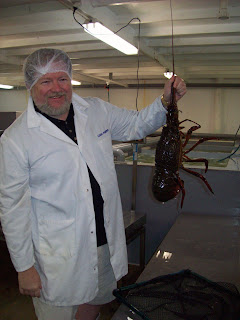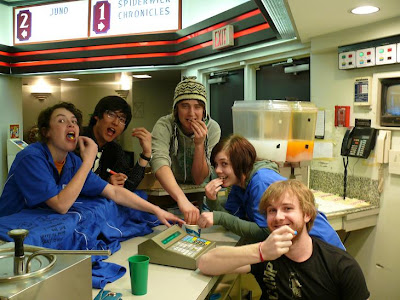It’s been two weeks since my return from New Zealand. My cubicle is cluttered with bottles of Antipodes water (counterintuitively pronounced an-TIH-puh-dees), my cufflink collection enhanced by a new pair — one cufflink a silhouette of the North Island, the other of the South Island — my DVR set to record every episode of Flight of the Conchords, to which I was introduced by the audio-visual system that I enjoyed during my trans-Pacific flight, flying business class, thank you very much.
Look at the seating in business class. That thing actually unfolds into a bed at the press of a button. It’s magic. I could live in Air New Zealand business class.
But my trip to New Zealand really ended in Matakana, which from what I can gather was once a little country town and is now a food-oriented getaway for wealthy Aucklanders. There’s a farmer’s market and cute shops with books and knickknacks and art galleries and a high end “butchery” and an organic ice cream shop. You get the idea.
We met in the home of Cuisine magazine food editor Lauraine Jacobs, who if she isn’t the doyenne of the greater Auckland culinary scene certainly could be.
She hosted a casual luncheon for us, and for her house guests Janie and Gary Hibler — Janie’s a food writer based in the Portland, Ore., area, so Bill already knew her, which is an amusing coincidence — along with Kim Crawford, who makes wines of that name, and some other representatives of New Zealand products, including Wayne Startup from The Village Press, an olive oil company, and Karen Brux from Zespri, the big kiwifruit company. I’d met Karen through IFEC, which isn’t that coincidental or amusing, but indicative of how disconcertingly small the food world is.
Also at lunch was Simon Woolley, the founder of Antipodes Water Co.
Kevin had brought along some sausage that a friend in Queenstown had made. Lauraine didn’t like it, but I did.
 Here’s Lauraine with a big bottle of Moa beer, which we drank along with Kim Crawford’s wine and Simon Woolley’s water. We also sampled Stonecutter Scotch Ale from Renaissance Brewing Co.
Here’s Lauraine with a big bottle of Moa beer, which we drank along with Kim Crawford’s wine and Simon Woolley’s water. We also sampled Stonecutter Scotch Ale from Renaissance Brewing Co.I mostly ate outside, at a picnic table under a gigantic umbrella, and somehow still managed to get sunburned. That Kiwi sun is murder, I tell you.
After lunch, Bill and I were pitched by Wayne, Karen and Simon about olive oil, kiwifruit and water (Kim Crawford left without pitching, apparently content to let the wines speak for themselves).
Did you know that Zespri sets prices for farmers based not on the size of the fruit but on its brix content? It seems like such an obvious way to help improve the quality of fruit, but I don't know that anyone else does it.
Here's what kiwifruit looks like on the vine.

We were supposed to spend the afternoon sailing, but the weather, once again, was inclement, so we repaired to our individual villas, where I updated my blog and took a nap in preparation for dinner, also at the home of the Jacobses.
Joining us, along with the Hiblers, was Sam Lewis, director of New Zealand Trade & Enterprise’s food and beverage taskforce, and an extremely interesting guy who spent a bunch of time overseas. I sat between him and Lauraine, and Sam and I had a great chat about life choices and values and stuff — at least I think we did; we drank a lot of New Zealand wine.
We must also have spoken about science fiction, as “Iain M. Banks” is written in my notes.
And we ate a delicious lamb dish that Lauraine made — a shank marinated with kaffir lime and other things. I told her about Bernie Oliver’s moves to sell the meat of Merino hoggets and she actually shuddered with disgust. Lamb, she insisted, should be served very young and mostly milk-fed. And I must say her lamb was the best I had in New Zealand.
I also see in my notes that she likes barrel-aged Sauvignon Blanc, showing that she doesn’t have qualms about going against conventional wisdom.
The next day we got up early to meet with Ian Langridge, Jim Dollimore and others at Snells Beach to take a barge to one of their oyster farms.
We did this in the wind and rain as New Zealand’s summer continued to elude us.
Their specialty, believe it or not, is frozen oysters that they sell on the half-shell. And you know what? They taste like oysters on the half shell.
This is a picture of one of their older farms, at which horizontal sticks are laid out within range of the tide. Microscopic young oysters are caught there and grow.
From there we met up with Lauraine again at Matakana market, a farmers market that also has prepared food, so I had a Vietnamese steamed dumpling (bahn bao) and a sausage in flat bread with rocket and sweet capsicum sauce (or, in American, arugula and sweet pepper sauce).
Here are Lauraine and Kevin in the market.

Then we wandered around the area, to that fancy book store and butchery I mentioned above, as well as an organic ice cream and sandwich shop called The Blue Ice Cream Cafe. It was the only organic ice cream and sandwich shop I had ever been in that had Eminem playing on its sound system (“Haile’s Song,” but still...). I drank a long black (which is what Antipodeans call a double espresso), and ate a blueberry ice cream cone.
We were leaving New Zealand that day, so you’d think we would have been done. But we went on to Brick Bay Wines in Matakana to drink and have a snack and then drove out to a kiwifruit farm to meet Carlos Verissimo,
 who shared with us information about the high water demands for kiwi fruit and its specific temperature needs (it needs to stay below 7° Celsius for a certain length of time for the fruit to set, but if it gets much below freezing the vines suffer).
who shared with us information about the high water demands for kiwi fruit and its specific temperature needs (it needs to stay below 7° Celsius for a certain length of time for the fruit to set, but if it gets much below freezing the vines suffer).From there we headed to the airport, so let’s just close this up with another picture of kiwi fruit — this time gold ones.















































